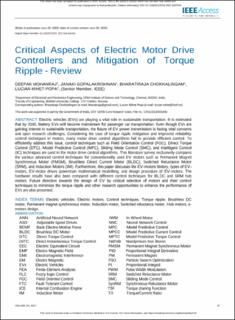| dc.contributor.author | Mohanraj, Deepak | |
| dc.contributor.author | Gopalakrishnan, Janaki | |
| dc.contributor.author | Chokkalingam, Bharatiraja | |
| dc.contributor.author | Mihet-Popa, Lucian | |
| dc.date.accessioned | 2022-09-22T15:09:01Z | |
| dc.date.available | 2022-09-22T15:09:01Z | |
| dc.date.created | 2022-06-23T15:23:11Z | |
| dc.date.issued | 2022 | |
| dc.identifier.citation | IEEE Access. 2022, 10, 73635 - 73674. | en_US |
| dc.identifier.issn | 2169-3536 | |
| dc.identifier.uri | https://hdl.handle.net/11250/3020734 | |
| dc.description.abstract | Electric vehicles (EVs) are playing a vital role in sustainable transportation. It is estimated that by 2030, Battery EVs will become mainstream for passenger car transportation. Even though EVs are gaining interest in sustainable transportation, the future of EV power transmission is facing vital concerns and open research challenges. Considering the case of torque ripple mitigation and improved reliability control techniques in motors, many motor drive control algorithms fail to provide efficient control. To efficiently address this issue, control techniques such as Field Orientation Control (FOC), Direct Torque Control (DTC), Model Predictive Control (MPC), Sliding Mode Control (SMC), and Intelligent Control (IC) techniques are used in the motor drive control algorithms. This literature survey exclusively compares the various advanced control techniques for conventionally used EV motors such as Permanent Magnet Synchronous Motor (PMSM), Brushless Direct Current Motor (BLDC), Switched Reluctance Motor (SRM), and Induction Motors (IM). Furthermore, this paper discusses the EV-motors history, types of EVmotors, EV-motor drives powertrain mathematical modelling, and design procedure of EV-motors. The hardware results have also been compared with different control techniques for BLDC and SRM hub motors. Future direction towards the design of EV by critical selection of motors and their control techniques to minimize the torque ripple and other research opportunities to enhance the performance of EVs are also presented. | en_US |
| dc.language.iso | eng | en_US |
| dc.publisher | IEEE | en_US |
| dc.rights | Navngivelse 4.0 Internasjonal | * |
| dc.rights.uri | http://creativecommons.org/licenses/by/4.0/deed.no | * |
| dc.subject | electric vehicles | en_US |
| dc.subject | electric motors | en_US |
| dc.subject | control techniques | en_US |
| dc.subject | torque ripple | en_US |
| dc.subject | brushless DC motor | en_US |
| dc.subject | permanent magnet synchronous motor | en_US |
| dc.subject | induction motor | en_US |
| dc.subject | switched reluctance motor | en_US |
| dc.subject | hub motors | en_US |
| dc.subject | e-motors design | en_US |
| dc.subject | reluctance motors | en_US |
| dc.subject | induction motors | en_US |
| dc.subject | torque measurement | en_US |
| dc.subject | permanent magnet motors | en_US |
| dc.subject | brushless DC motors | en_US |
| dc.subject | torque | en_US |
| dc.subject | control systems | en_US |
| dc.title | Critical Aspects of Electric Motor Drive Controllers and Mitigation of Torque Ripple - Review | en_US |
| dc.type | Peer reviewed | en_US |
| dc.type | Journal article | en_US |
| dc.description.version | publishedVersion | en_US |
| dc.subject.nsi | VDP::Teknologi: 500::Elektrotekniske fag: 540 | en_US |
| dc.source.pagenumber | 73635 - 73674 | en_US |
| dc.source.volume | 10 | en_US |
| dc.source.journal | IEEE Access | en_US |
| dc.identifier.doi | 10.1109/ACCESS.2022.3187515 | |
| dc.identifier.cristin | 2034614 | |
| cristin.ispublished | true | |
| cristin.fulltext | original | |
| cristin.qualitycode | 1 | |

